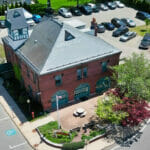Dear members of the Reading community,
I was heartened to see that the instructional motion proposing guidelines to limit MBTA Communities-compliant zoning changes failed to pass Town Meeting on Monday (April 29). After watching the discussion, I felt compelled to share my perspective about why exactly I think this alternative approach would be worse for Reading than the most recently proposed zoning map and bylaw amendments (link).
There is understandably a lot of apprehension about potential changes and disruptions to town which might result from zoning changes. Some have proposed that the best way to mitigate these disruptions would be essentially to sequester as much of the new, by-right multi-family housing zoning to “underutilized” areas (i.e. in current Commercial and Industrial zones), and avoid as much as possible any changes to single-family housing (SFH) zones.
I would argue that the least disruptive option, and indeed one that carries many positive benefits, would be something like the currently proposed plan. This plan upzones some of the SFH areas around the downtown core to allow multi-family housing by right. I argue this with three main ideas in mind:
- Gradual change which is easier to accommodate
- Benefits of development for existing residents
- Expansion of housing options for seniors and younger generations
Gradual change which is easier to accommodate
By the very nature of ownership structure and size/shape of property parcels, any actual changes that happen in upzoned residential areas will be incremental and organic. Development will happen based on decisions by individual property owners to expand their principal building, build an accessory unit, or sell their property to someone else who might demo and rebuild as, say, a triple-decker. These changes won’t happen all at once, won’t happen all in one place, and crucially, won’t manifest as mid-rise apartment blocks (because the lot sizes are simply prohibitive). Residents are less likely than big developers to build their lots to the max in pursuit of returns. New residents would be integrated into strong, existing communities.
Conversely, the lots are generally much larger in the alternative proposal. If residential development were to occur, it would be on a large scale and aim to strictly maximize return (i.e. density) for an outside developer. There’s no way for development of some of these proposed lots (e.g. 1 General Way) to be gradual or incremental. At Town Meeting, the Reading Woods development was given as a positive example of what would be possible by putting the new multi-family zoning in, say, an underutilized Industrial area. As a reminder, this was 400+ units that went online nearly simultaneously. Is that meant to be less disruptive than the scenario described above? The lots in the Commercial zone are generally smaller than this, but if developed would still likely manifest as low-rise or mid-rise apartments, with the impacts being concentrated on abutters of these districts.
In terms of impact on town infrastructure, DPW and Engineering have already expressed confidence that existing water and sewer systems could accommodate the currently proposed plan. So in the near-term, this would mean new ratepayers connected to existing infrastructure. Contrast this with possible large-scale residential redevelopment of Industrial or Commercial zones, which would likely require costly new infrastructure expansion. If you are concerned about traffic and parking in downtown Reading, it certainly makes more sense to put increased density close to the downtown core, rather than far away where the only reasonable option to get into town would be to drive and park. And if you are concerned about the impact on our schools, it goes without saying that gradual change is easier to plan for than a large bolus of new residents.
Benefits of development for existing residents
Simply put, the current proposal to upzone some SFH areas would make Reading residents the beneficiaries of potential future development. It would allow current residents of those new zones to increase the value of their property by building improvements on it, as well as open up the possibility of generating income by renting out a newly built unit. In the alternative plan, redevelopment and the attendant rewards would be captured by professional development firms, not Reading residents.
Expansion of housing options for seniors and younger generations
There has been much discussion recently about the increasing proportion of Reading residents aged 60+ (26% and growing), and how best to ensure that Reading remains a welcoming place for that population. A ReCal report commissioned by the town (link) found that the greatest concerns for residents hoping to age in place are the costs of living (driven largely by property taxes) and the availability of appropriate housing options.
Allowing one to expand their home to multiple units or add an accessory unit by right can go a long way to address both of these concerns. It creates the option to downsize while staying on one’s existing property and remaining part of one’s existing community. It allows one to create accommodation for adult children or caregiver, as well as the possibility of an additional income stream in retirement. The AARP strongly supports the right to build accessory dwelling units as a means of expanding housing options for both seniors and younger generations of their families (link). If we can give aging residents more options that make it possible to remain as members of the community which they have helped build for decades, I think we have that responsibility.
In conclusion, I think that embracing an approach which allows for incremental growth is least likely to cause disruption, and most likely to provide benefits to Reading residents. The proposed alternative, which would concentrate as much as possible new multi-family zoning in Commercial and Industrial districts, would be much more likely to result in large-scale developments, would cut in to the already very limited supply of non-residential land in Reading, and would more severely impact select residents who abut these areas. It would also shift the decision-making about what gets built when from primarily individual Reading residents to external real estate investors and property developers. I believe that these same arguments support (among other reasons) a decision to do more than the absolute minimum in terms of area that is being rezoned, as expanding the rights of more Reading residents to do as they please to improve their property and benefit from the results is a good thing.
Whatever your perspective, I would encourage all to sign up for updates from the planning division (link) and be engaged in the process, so that we can end up with the best possible plan when Town Meeting convenes again in November.
Sincerely,
Liam Loscalzo
Federal Street










